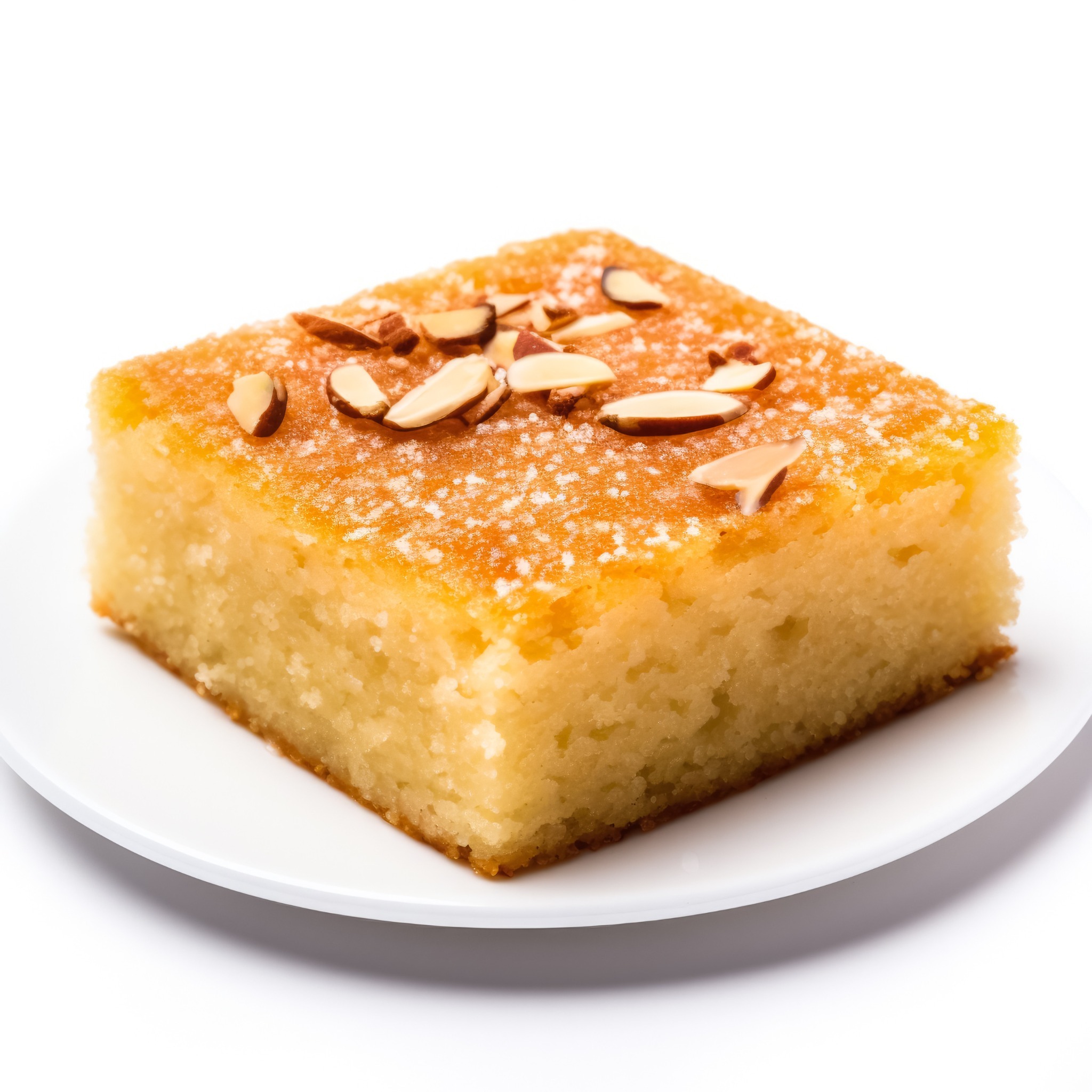
Basbousa, also known as Hareeseh, Revani, or Harisa, is a popular Middle Eastern and North African dessert that has found its way into the hearts of sweet enthusiasts around the world. This delectable treat, characterized by its semolina base and sweet syrup, holds a special place in the culinary traditions of the region. Let’s explore the origins, ingredients, preparation, and cultural significance of basbousa in this flavorful journey.
Origins and Name
Basbousa has a rich history that dates back centuries, with its roots deeply embedded in the Middle East and North Africa. The exact origin of the dessert is challenging to pinpoint, as variations of it are found in various countries across the region. The name “basbousa” is believed to have originated from the Arabic word “basbasa,” which means “to soak” or “to moisten.” This name aptly describes the dessert’s characteristic preparation method, where it is soaked in a sweet syrup after baking.
Ingredients
The ingredients for basbousa are simple and readily available, yet they come together to create a symphony of flavors and textures. The core components include semolina, sugar, yogurt, butter or ghee, baking powder, and desiccated coconut. Additionally, some recipes may incorporate ground almonds or coconut flakes for added richness and texture. The star of the show, semolina, gives basbousa its unique coarse texture, setting it apart from other desserts.
Preparation
The preparation of basbousa involves a series of straightforward yet crucial steps, each contributing to the dessert’s distinct taste and texture.
- Mixing the Batter: Semolina is combined with sugar, yogurt, melted butter or ghee, and sometimes ground almonds. Baking powder is added to provide the necessary leavening, resulting in a light and airy texture.
- Resting Period: The batter is allowed to rest for a period, allowing the semolina to absorb the liquid ingredients. This step ensures the desired coarse yet moist texture of the final product.
- Baking: The batter is poured into a greased baking dish and baked until golden brown. The result is a deliciously fragrant cake with a slightly crispy exterior.
- Syrup Soaking: Once the basbousa is out of the oven, it is immediately drenched in a sweet syrup. This syrup typically includes sugar, water, and sometimes a touch of lemon juice or rose water. The hot basbousa readily absorbs the syrup, infusing it with sweetness and moisture.
Variations
While the core ingredients and preparation remain consistent, there are regional variations and personal adaptations of basbousa. Some recipes may include flavorings such as orange blossom water or rose water, adding a floral note to the dessert. Others might incorporate ground pistachios or almonds on top for a nutty crunch. These variations reflect the diverse culinary landscape of the Middle East and North Africa.
Cultural Significance
Basbousa holds cultural significance beyond its delightful taste. It is a staple at celebrations, including weddings, religious holidays, and family gatherings. The act of sharing basbousa is a gesture of hospitality and warmth in Middle Eastern and North African cultures. The dessert embodies the essence of togetherness, making it a symbol of joy and community.
Global Popularity
In recent years, basbousa has transcended its regional origins and gained popularity worldwide. Its appeal lies in its simplicity, unique texture, and the harmonious combination of sweetness and moisture. As global culinary tastes continue to evolve, basbousa has become a favorite in many dessert aficionados’ repertoires.
Basbousa is not merely a dessert; it is a cultural icon that brings people together through the shared experience of savoring its delicious flavors. Its journey from the kitchens of the Middle East and North Africa to international tables showcases the power of food to transcend borders and connect people. Whether enjoyed during festive occasions or as a delightful treat on a regular day, basbousa remains a testament to the rich culinary heritage of the regions it represents. So, the next time you indulge in a piece of basbousa, savor not just the sweetness on your palate but the centuries of tradition and culture baked into every crumb.
Ingredients
For the Basbousa:
- 2 cups semolina
- 1 cup granulated sugar
- 1 cup plain yogurt
- 1 cup unsalted butter, melted
- 1 cup desiccated coconut
- 1 teaspoon baking powder
- 1/2 cup blanched almonds or pine nuts (for garnish, optional)
For the Syrup:
- 2 cups granulated sugar
- 1 cup water
- 1 tablespoon lemon juice
- Optional: A splash of rose water or orange blossom water for flavor
Preparation
1. Preparing the Batter:
- In a large mixing bowl, combine the semolina, sugar, yogurt, melted butter, desiccated coconut, and baking powder.
- Mix the ingredients thoroughly until well combined, ensuring there are no lumps. The batter should have a smooth consistency.
2. Resting Period:
- Allow the batter to rest for at least 30 minutes. This resting period enables the semolina to absorb the moisture from the yogurt and butter, resulting in a desirable texture.
3. Preheat the Oven:
- Preheat your oven to 350°F (175°C). Grease a baking dish or a 9×13-inch pan to prevent sticking.
4. Pouring the Batter:
- After the resting period, give the batter a gentle stir to ensure an even texture. Pour the batter into the greased baking dish, spreading it out evenly.
5. Baking:
- Bake in the preheated oven for approximately 30-40 minutes or until the top is golden brown and a toothpick inserted into the center comes out clean. The exact baking time may vary, so keep an eye on it to avoid over-baking.
6. Preparing the Syrup:
- While the basbousa is baking, prepare the syrup. In a saucepan, combine sugar, water, and lemon juice. Bring the mixture to a gentle boil, stirring occasionally.
- Let the syrup simmer for about 10 minutes or until it slightly thickens. If desired, add a splash of rose water or orange blossom water for a fragrant touch.
- Remove the syrup from heat and allow it to cool.
7. Soaking the Basbousa:
- Once the basbousa is out of the oven, immediately pour the cooled syrup evenly over the hot cake. This step allows the basbousa to absorb the sweet syrup, infusing it with flavor and moisture.
8. Garnishing (Optional):
- While the basbousa is still warm, you can decorate it by placing blanched almonds or pine nuts on top in a decorative pattern. This adds both visual appeal and a delightful crunch.
9. Cooling and Serving:
- Allow the basbousa to cool and absorb the syrup for at least an hour before cutting it into squares or diamond shapes. This dessert is often served at room temperature.
10. Enjoying the Delight:
- Serve the basbousa on a platter and enjoy the delightful combination of the slightly crispy exterior and the moist, sweet interior. It pairs wonderfully with a cup of tea or coffee.
Tips:
- Adjust the amount of sugar in the syrup to suit your sweetness preference.
- Experiment with adding a pinch of ground cardamom to the batter for an extra layer of flavor.
- Make sure to use fine semolina for the best texture.
- If you’re feeling adventurous, try incorporating a handful of ground almonds or coconut flakes into the batter for added richness.
This homemade basbousa recipe allows you to bring the flavors of the Middle East to your kitchen. The combination of semolina, yogurt, and sweet syrup creates a dessert that is not only delicious but also a symbol of warmth and hospitality. Share these bite-sized pieces of joy with your loved ones, and let the sweet aroma of basbousa fill your home with the spirit of Middle Eastern cuisine. Enjoy every moment of preparing and savoring this delightful treat!



Leave a Reply